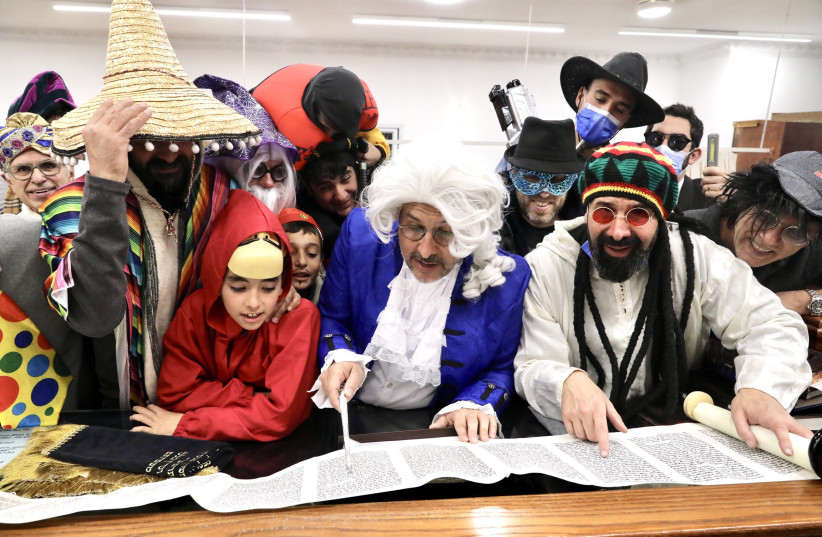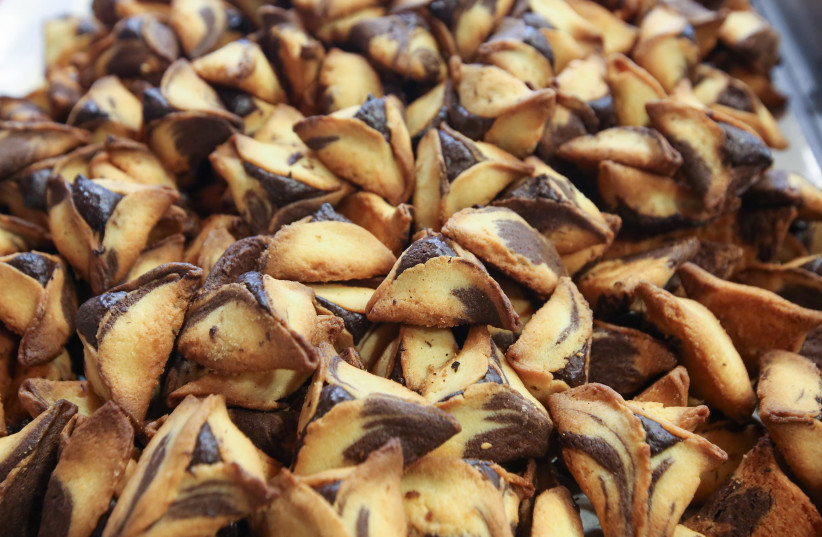Purim is easily one of the most iconic Jewish holidays, especially in Israel. While not the most important of holidays, it is certainly one of the most beloved.
With a history steeped in celebration and colorful expression, Purim has developed a unique identity among the long roster of Jewish religious festivals.
Further, it has also developed a host of rules, traditions, and iconic symbols and activities.
However, Purim also has a very famous story behind it, with the legendary tale of Queen Esther in the Persian empire, thwarting the attempted genocide of the Jews plotted by the villainous Haman.
Here is everything you need to know about the Purim holiday, from its origins to its celebrations today.

The meaning of Purim: What is the history of this unique Jewish holiday?
The story of Purim is found in the Bible, as recounted in the Book of Esther, known in Hebrew as Megillat Esther.
The story is famous, but here is a very abridged version.
In the years after the destruction of the First Temple, the Jewish people were sent into exile. Many would wind up living in the city of Shushan, the capital of the Persian Empire, ruled by King Ahasuerus.
After the king executes his disobedient wife, Vashti, he attempts to find a new one. A Jewish woman using the alias of Esther, the relative of a well-known Jew named Mordechai, is eventually chosen to become the new queen.
Meanwhile, the king's viceroy, the villainous Haman, plots to kill all the Jews after he is furious at Mordechai for not bowing before him. He manipulates Ahasuerus to get permission to do so, choosing a date in the month of Adar for the planned genocide.
Mordechai finds out about this and pleads with Esther to intervene, though she fears being executed for breaking royal protocol by going to him without being summoned. After all the Jews fast for three days, she goes before Ahasuerus, who doesn't execute her, and invites both him and Haman to attend two feasts.
During this time, Haman builds gallows to hang Mordechai, while a humiliated Haman parades Mordechai through the city to reward him for thwarting an assassination attempt on the king.
At the second feast, the king promises to grant Esther any wish, and she reveals that she is Jewish and Haman is planning to kill her and her people. This thwarts Haman's plot, and he is hanged on his own gallows. The royal decree of genocide Haman made is now amended, allowing the Jews to fight back and slay their would-be killers, with tens of thousands ultimately slaughtered. Ahasuerus continues his reign, Mordechai becomes a high-ranking official, and the Jews throughout the empire create an annual celebration.
The book itself is believed to be written by Mordechai himself and is thought to be dated to as far back as the 4th century BCE.
In terms of its historical accuracy, scholars have noted the Book of Esther as being inconsistent. The Persian Empire was very much real, classified by historians today as specifically being the Achaemenid Empire, and Shushan is believed to be the city of Susa. Ahasuerus is certainly meant to refer to a Persian king, though which one is unclear. However, it is widely believed to refer to Xerxes I, who reigned between 486 and 465 BCE and spent many years of his reign battling the Greeks in the Greco-Persian Wars.
Other elements are noted to be real. Haman's offense over Mordechai not bowing before him makes more sense when considering the role bowing played in Persia, as it was a very important display of respect. Refusing to bow like this was a serious offense, with the practice of bowing before a mortal explicitly being mentioned by the Greek military leader and historian Xenophon as something that separated them from the Persians. He went so far as to write in his text the Anabasis that the refusal to bow down was the "strongest witness" to the Greek victory over Persia, "for to no human creature do you pay homage as master, but to the gods alone."
Esther and Mordechai as characters are a source of greater historical debate. However, the Talmud insists they were real people, and there are ancient Persian records indicating that at least four people with similar names (Marduka, Marduku) served in the Persian court. Others theorize that they may be allusions to or were inspired by the Babylonian pagan deities Marduk and Ishtar. Indeed, many scholars have further claimed that the story itself is based on a Babylonian myth, or an existing Persian holidays.
Regardless, the Purim holiday has persisted for millennia and has formed an integral part of Jewish culture.

Purim customs: What are the rules and traditions of the holiday?
As documented in the Book of Esther itself, the rules of the holiday are as follows:
- Celebrate and be happy
- Have a feast, known now as a Seudat Purim
- Send and receive portions of food to one another, known now as mishloach manot or Purim gift baskets
- Give gifts to the poor, known now as matanot le'evionim
- Recount the story of Purim, celebrated by reading the Book of Esther, something that is done twice a year
There is also a requirement to fast on the day before Purim, a day known now as the Fast of Esther.
But while those are explicitly the only rules, there are a few other traditions that have been passed down throughout time.
The first and most famous tradition is wearing Purim costumes, wherein people dress up in different costumes as a day of making merriment and as part of the holiday's "topsy-turvy" tradition.
Alcohol is another big part of the holiday, with some believing one should be so drunk that they cannot tell the different between "bless Haman" and "curse Mordechai," though we at The Jerusalem Post agree with medical experts that one should still avoid drinking too much alcohol.
Another tradition, specifically in Israel, is parades, known locally as Adloyada.
Another tradition takes place during the reading of the Book of Esther, where upon every mention of Haman's name, those listening loudly boo and make disruptive noises, most famously by using noisemakers known as Purim groggers.
Other traditions include changes to prayer, such as a spcial Torah and haftorah reading, as well as the addition of the "Al Hanisim" prayer in grace after meals and in daily prayer.
But there are also traditional foods eaten on the holiday.

Purim food: What do we eat?
The most iconic of foods associated with the holiday are Purim cookies known as hamantaschen or oznei Haman.
These cookies are folded in the shape of a triangle with a filling at the center, the most traditional of them being poppy seed paste. The historical origins of hamantaschen and the reason for their name and shape are not agreed upon, but it is known that they have long been tied to Purim, and that the poppy seed paste is the original filling. However, nowadays, a number of other fillings have cropped up, such as jam and chocolate.
Purim 2024 dates: When does the holiday begin?
In most of the world, Purim is supposed to occur on the 14th day of the Hebrew month of Adar (or Adar 2, during leap years), with the Fast of Esther being on the 13th. However, there are two caveats to this.
The first is that the Fast of Esther can never be observed on Shabbat, as with the exception of Yom Kippur, Jewish law prohibits fasting on Shabbat.
When this happens, the Fast of Esther must be observed on the preceeding Thursday.
The second is about Shushan Purim.
The megillah specifically states that in the city of Shushan and in other walled cities, Purim is not celebrated on the 14th of Adar, but on the 15th. Traditionally, this day was only celebrated in cities that were walled during the time of the biblical prophet Joshua.
Of the many cities, the only one we are definitively sure was walled at the time is Jerusalem, where Shushan Purim is observed. There are some other cities where there is considerable doubt if it was walled at the time, such as Jaffa, Hebron, Acre, and Tiberias. There, many people simply observe two days of Purim.
As is the case with all Jewish holidays, Purim begins at night and ends the next night, meaning it begins on the night of a Gregorian date and ends on the night of the next date.
Here are the times for Purim 2024.
| City name | Purim start time |
| New York | Saturday, March 23, 7:54 p.m. |
| Los Angeles | Saturday, March 23, 7:50 p.m. |
| Tel Aviv | Saturday, March 23, 6:32 p.m. |
| Haifa | Saturday, March 23, 6:31 p.m. |
| Beersheba | Saturday, March 23, 6:31 p.m. |
| Eilat | Saturday, March 23, 6:29 p.m. |
| Jerusalem | Sunday, March 24, 6:30 p.m. |
